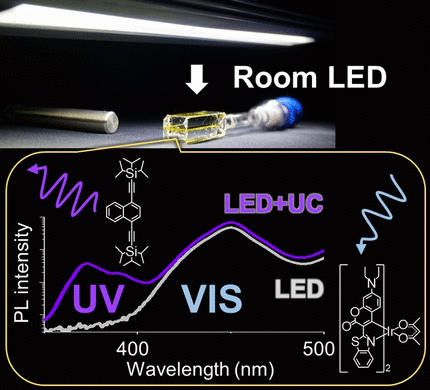Dec 21 2020
In general, fluorescence involves the transformation of light at shorter wavelengths to light at longer wavelengths. Now, researchers have come up with a new chromophore system that works inversely.

Image Credit: © Wiley-VCH, Angewandte Chemie.
When fluorescent dyes are excited by visible light they emit light in the ultraviolet region. Published in the Angewandte Chemie journal, the new study reports that light upconversion systems such as those could increase the light-dependent reactions for which efficiency tends to be essential, like solar-powered water splitting.
At shorter wavelengths (high energy, for example, blue light), fluorescent dyes tend to absorb light and at longer wavelengths (low energy, for example, red light), they emit light. Upconversion of light is even more complicated to achieve. Upconversion implies that a fluorescent dye is excited with radiation in the visible range but emits light in the ultraviolet range.
These dyes can be employed to perform high-energy catalytic reactions like solar-powered water splitting simply by making use of normal daylight as the energy source. Dyes such as these would extend the available excitation energy range.
Nobuhiro Yanai and his collaborators at Kyushu University, Japan, are investigating multi-chromophore systems for their potential to upconvert fluorescence light. Yanai describes how upconversion works:
Fluorescence upconversion occurs when two chromophore molecules, which have been excited in the triplet state by a sensitizer, collide. This collision annihilates the sensitized energy and lifts the chromophores to a higher energy level. From there, they emit the energy as radiation.
Nobuhiro Yanai, Kyushu University
But it is hard to realize effective upconverting chromophore designs practically—current systems require high-intensity radiation and do not yet realize over 10% efficiency.
The main reason for the low efficiency is that the sensitizer chromophore molecules also absorb much of the upconverted light, which is then lost.
Nobuhiro Yanai, Kyushu University
By contrast, the donor–acceptor chromophore pair designed by Yanai and his team shows energy levels that are so delicately adjusted that it reached a record-high upconversion efficiency of 20%.
There was virtually no occurrence of back-absorption and low nonradiative loss. The novel chromophore pair included an iridium-based donor, which was a standard sensitizer, and a naphthalene-derived acceptor, which was a novel compound.
Low back-absorption and some radiative losses indicate that the intensity of the exciting radiation could be low. According to the team, the solar irradiance was enough to realize high upconversion efficiency.
Indoor applications were even viable with artificial light. The researchers held an LED lamp over an ampoule loaded with the chromophore solution and quantified the intensity of the discharged UV light.
Journal Reference:
Harada, N., et al. (2020) Discovery of Key TIPS-Naphthalene for Efficient Visible-to-UV Photon Upconversion under Sunlight and Room Light. Angewandte Chemie International Edition. doi.org/10.1002/anie.202012419.